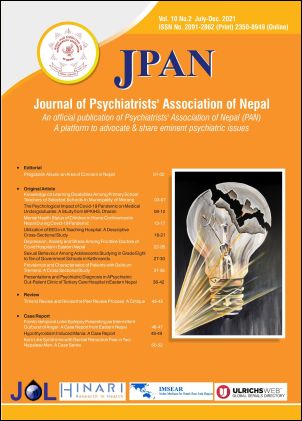Sexual Behaviour Among Adolescents Studying in Grade Eight to Ten of Government Schools in Kathmandu
DOI:
https://doi.org/10.3126/jpan.v10i2.49003Keywords:
Adolescent, Government schools, Kathmandu, Risky sexual behaviourAbstract
INTRODUCTION Risky sexual behaviour among adolescents has been a major concern around the globe. In developing countries like Nepal such behaviours have cost a lot in terms of major social issues. The main objective of this study was to explore risky sexual behaviour among school students studying in grade eight to ten of government school in Kathmandu district.
METHODOLOGY A descriptive cross-sectional study was carried out among school students studying in grade eight to ten in government school. Data were collected using self-designed semi-structured proforma and Youth Risk Behaviour Surveillance survey (YRBSS) developed by Centre for Disease Control (CDC) in 1990. Three Government schools randomly selected from two Resource centres were taken for the study. Among 620 students selected altogether,532 completed questionnaires were collected.
RESULT The percentage of participants who had sexual intercourse during their lifetime was 15.0%. Among them 20.5% male and 9.9% female had sexual intercourse during their lifetime (p-value 0.001). At the age of 13, 4.3% had sexual intercourse and 4.9% had sexual intercourse with two people during their lifetime. During the past 3 months, 2.8% had sexual intercourse with at least one person.
CONCLUSION This study showed the burden of risky sexual behaviours among school students. Proper interventional programs should be started promptly to address such issues by concerned authority and related stake-holders of this field.
Downloads
Downloads
Published
How to Cite
Issue
Section
License
Copyright (c) 2021 Journal of Psychiatrists' Association of Nepal

This work is licensed under a Creative Commons Attribution 4.0 International License.
This license enables reusers to distribute, remix, adapt, and build upon the material in any medium or format, so long as attribution is given to the creator. The license allows for commercial use.




